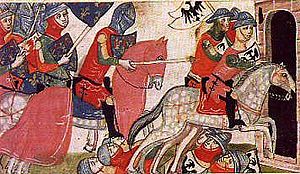Battle of Benevento
| date | February 26, 1266 |
|---|---|
| place | At Benevento in southern Italy |
| output | Guelfan victory |
| Parties to the conflict | |
|---|---|
|
Guelfs (French and mercenaries) |
Ghibellines ( Kingdom of Sicily , HRR , mercenaries) |
| Commander | |
| Troop strength | |
| 4,600 cavalry, unknown number of infantry |
3,600 heavy cavalry, 300 light cavalry, 10,000 archers |
| losses | |
|
unknown |
more than 2,500 riders, infantry not known |
The Battle of Benevento took place on February 26, 1266 near Benevento in southern Italy between the troops of Charles of Anjou and Manfred of Sicily . Manfred's defeat and death led to the conquest of the Kingdom of Sicily by Charles.
background
The papacy had long been in conflict with the imperial dynasty of the Staufer because of the balance of power in Italy . In 1266 the Kingdom of Sicily, including parts of southern Italy, was ruled by Manfred from Staufer, an illegitimate son of Emperor Friedrich II, who died in 1250 . The rightful heir to the throne, Friedrich's legitimate grandson Konradin , was north of the Alps in Bavaria , and when the (false) news came that Konradin had died there, Manfred had ascended the throne in 1258. Pope Urban IV decided to withdraw the kingdom from him (Sicily was a papal fiefdom) and in 1263 concluded a secret treaty with Charles of Anjou , through which Sicily was awarded.
prehistory
Charles (the brother of Louis IX , King of France) reached Rome in 1265, where he was stopped due to financial difficulties. Manfred also only went into the field in January 1266, when Karl's main army had already crossed the Alps. Alerted by desertion in his troops and fearing further betrayal, Manfred tried to force Karl into a decisive battle as quickly as possible. Karl tried to shake Manfred's position by a risky crossing of the Apennines , but this only destroyed his supply lines. However, Manfred had learned of Karl's maneuvers and holed himself up in a strong position on a bridge on the Calore River , which could only be crossed at this point.
Karl had set up his cavalry in three lines. The infantry and the first part of the cavalry, 900 Provençals , withdrew in front under the command of Guido von Mirepoix and Philipp von Montfort , Herr von Castres ; behind were 400 Italians, 1,000 men from Languedoc and central France under Charles' command; in the rear, 700 horsemen from northern France and Flanders stood under the command of Gilles de Trazegnies , Connétable of France , and Robert III. of Flanders .
Manfred had made similar arrangements. His Saracen archers lay at the front, behind them 1,200 German mercenaries in plate skirts (a novelty at the time), commanded by Giordano Lancia and Galvano of Anglona. The second line consisted of about 1,000 Italian mercenaries and 300 Saracen light riders under the command of his uncle Galvano Lancia . The third line, 1,400 soldiers, were the barons of the kingdom under Manfred's personal command.
The battle
There is no reliable information about the course of the battle. The folk tale has survived:
The battle began in the morning when Manfred let his Saracens (archers and some light riders) advance across the bridge. They chased out Karl's infantry, but were themselves put to flight by his first line. It is not known whether it was on his own initiative or on Manfred’s orders. Manfred’s first line crossed the bridge to counterattack. At first the German mercenaries seemed unstoppable, all attacks ricocheted off their metal plates, so that Karl was forced to send his second line into battle. The German mercenaries continued their advance until the French discovered that the German armor could not protect the armpits when the arm was raised to strike. Because of this knowledge, the Germans could be defeated.
The battle now turned quickly against Manfred. His troops were forced to cross the bridge to get onto the battlefield. When his second line got to the other side of the river, Karl attacked it from the flanks through his third line, which quickly destroyed it. Faced with the defeat of the Italian mercenaries, most of the Sicilian nobles deserted in Manfred's third line. After exchanging his royal tabard with his friend Tebaldo Annibaldi, Manfred and his remaining followers threw themselves into battle and were soon killed.
Aftermath
With the destruction of Manfred's army, the rule of the Hohenstaufen in Italy collapsed. The Kingdom of Sicily was conquered with almost no resistance, so that Charles was soon firmly in the saddle and could calmly wait for the arrival of Conradin, whom he defeated in 1268 in the battle of Tagliacozzo .
literature
- Steven Runciman : The Sicilian Vespers, 1958, ISBN 0-521-43774-1
- Oliver Lyman Spaulding, Hoffman Nickerson: Ancient and Medieval Warfare, 1993, ISBN 1-56619-241-2
source
- Guillaume de Nangis , Gesta Sancti Ludovici , ed. by M. Daunou in the Recueil des Historiens des Gaules et de la France (RHGF) , Vol. XX (Paris, 1840), pp. 422-427
